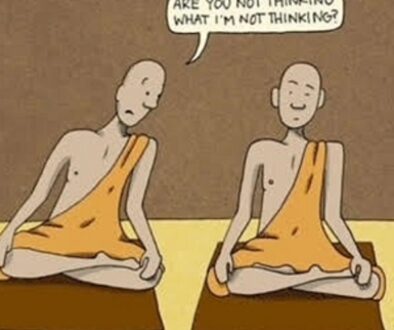First Chapter Preview: Ask the Awakened, The Negative Way By Wei Wu Wei
 |
ASK THE AWAKENED The Negative Way by Wei Wu Wei |
PART I The Cross-Roads
Why are you unhappy? Because 99.9 per cent of everything you think, And of everything you do, Is for yourself— And there isn’t one.
1 – The Harlequinade
Perhaps our most serious handicap is that we start on the wrong foot. In the end this is likely to be fatal, and, I fear, generally is. We have a basic conditioning, probably in some form of Christian religion, of which little remains today but its ethical content, or in one of the modern psychologies, that of Freud, Adler, or Jung, or in some scientific discipline, all of which are fundamentally and implacably dualist. Then the urge manifests, and we start reading.
Every time we happen on a statement or sentiment that fits in with our conditioned notions we adopt it, perhaps with enthusiasm, at the same time ignoring, as though they did not exist, the statements or sentiments which either we did not like or did not understand.
And every time we re-read the Masters or the sutras we seize upon further chosen morsels, as our own jig-saw puzzle builds up within us, until we have a personal patchwork that corresponds with nothing on Earth that could matter in the least. Not in a thousand million kalpas could such a process produce the essential understanding that the urge is obliging us to seek.
We are required to do exactly the opposite of all that. We are required to “lay down” absolutely everything that is “ours,” and which is known as “ignorance”—even though we regard it as knowledge. It is like stripping off clothes that have become personal. Then naked, but in a nakedness that does not recognize itself as such, we should go to the Masters, who will clothe us in the garments of the knowledge or understanding that we really need. It is their jig-saw we must com-plete, not “ours,” for their “doctrine,” what they have to reveal to us, is one whole and indivisible, and the statements and sentiments that we do not at once understand, rather than those that we think we do, are the ones that matter. One by one as we re-read, and finally all at once, their meaning will become manifest, and we shall at last understand what the Masters have to tell us. Then, and only then, can we acquire their understanding, which is the fulfillment of the urge.
As busy little bees, gathering honey here and there, and adding it to their stock in their hive, we are wasting our time, and worse, for we are building up that very persona whose illusory existence stands between our phenomenal selves and the truth of what we are, and which is what the urge in us is seeking. That “laying down” of everything that is “ours” has always been insisted upon by the Masters, but we affect to ignore it, precisely because that very notion of “self” which is the center of what we have to “lay down” seeks to take charge of the operation, and generally succeeds in doing so, thereby frustrating from the start any hope of fulfilling the urge. Is there any wonder that we so rarely get anywhere at all?
It is interesting to note that in the recently discovered collection of sayings of Jesus there is one in which he formally adjured His disciples to divest themselves of all their “garments.” It is understandable that such a statement should have been omitted by those later compilers who had no idea what such a requirement could mean. But to us it should be a commonplace. As far back as Chuang-tse we find the story of the old monk who, in despair of knowing enlightenment before he died, went to see Lao-tse. On arrival Lao-tse came out to meet him, welcomed him, but told him to leave his followers and his baggage outside the gate, for otherwise he would not be admitted. The old man had no followers, and no baggage, but he understood, went in and found his ful-fillment.
2 – Ask the Awakened
Since Bodhidharma, the recurrent menace that has overshadowed the Supreme Vehicle has been man’s infatuation with himself. Whenever the succession of great Masters weakened in power or in quality the self-flattering mirror-polishing doctrine re-emerged.
Hui Neng and Shen Hui rescued the doctrine, but today it needs saving again, for, in the West at least, we are nearly all busy polishing our mirrors, or perfecting the hansom-cab as I have termed it, instead of understanding that neither the polisher nor mirror, perfector nor cab, has ever or could ever exist.
What we need is another Bodhidharma, firm as a rock, fierce as a tiger, merciless in his “grandmotherly kindness,” and not afraid to tell Emperors of China that they are talking through their hats. And if we cannot hope for a Bodhidharma, then at least we need desperately a Hui Neng. Otherwise, though Buddhism may survive, the Supreme Vehicle will surely be lost.*
And only the Supreme Vehicle ultimately matters, for self-exalting Buddhism is pseudo-Buddhism, for it is a contradiction in terms, a soothing syrup or a drug: only the Supreme Vehicle carries the full and final message of the Tathagata.
As long as we do not perceive the fatuity of a phenomenon telling itself how marvelous it is, we will never come to the knowledge of that which we are when we have understood that, as phenomena, we are not.
*Hubert Benoit describes Bodhidharma as “an ‘Awakener,’ someone who comes, with kindness but also with implacable firmness, to rouse us from the dream in which we are living.”
3 – The Cross-Roads of Time and Space
“The present has no extension but intensity.” (Lama Anagarika Govinda.)
The present has no duration. Therefore it does not exist in the lineal dimension of time. It is not “horizontal.” It has only a point of contact with seriality.
The extension of the present is in another dimension to that of time. It is therefore at right-angles to time. The direction of measurement of this essentially timeless dimension is—within.
That is the reason of the importance instinctively given tomomentanéité, to “presence in the present,” to “spontaneity,” and the reason of the creation of expressions such as “the Eternal Present.”
The so-called present is our link with the dimension that includes the three we already know and use. It is the point at which Time cuts across Space, and as a concept it is spatial rather than temporal.
The present is not a fleeting moment: it is the only eternity. In Time “lies” samsara: in the Present “lies” nirvana. Time is the measurement of objectivity: the Present is the presence of subjectivity, in which everything potentially is, and from which, in Time, everything is apparently projected.
The assumed (so-called) present is our point of contact with bodhi-mind. It is the invisible portal through which intuition reaches us from the interior of ourselves, from that universal and limitless interior (spatially thought-of) which is all we ever were or ever will be, and which is out of time. It is the sole line of communication between our enveloping totality and our apparent existence as separate individual creatures, between our universality and our illusory particularity, between the noumenality and the phenomenality of all sentient beings.
The present alone in our experience is what IS, and phenomenally it is not; for it is only an imaginary division between past and future—like the equator between the northern and southern hemispheres. It is like a fictional line of latitude that is a symbol rather than an existence, and yet represents a vital transmission from one sphere to another, from north to south, from past to future, neither of which has any reality in itself but each of which is a concept that artificially divides a continuity in space or in time.
The present alone represents that which we are in an apparent world in which we are not, since therein we are appearances (phenomena) only. We ourselves neither exist nor do we not exist. Neither existing samsarically nor not-existing nirvanically, we are nothing—in any way in which we can know ourselves—but as the Present.
Note: The present is the dimension I have indicated by the image of “vertical” being or seeing, which is an essential discrimination for comprehending in what manner we (sentient beings) can be understood to BE. It is also the dimension in which occurs whatever actuality there may be in the expression “living in Zen,” and in “when I am hungry, I eat; when I am weary, I sleep”—in the manner in which the awakened Masters themselves did that.
4 – He Who Gets Slapped
When I was a child I was taken to the circus. There I saw a long series of entrancing performances that caused men and animals to execute every kind of astonishing and unexpected maneuver. And throughout, but particularly when the scenario and its appurtenances were being changed, there appeared a grotesque personage, vaguely resembling a human being, who interfered with everything but effected nothing. He fell over the carpets, bumped himself against every object, was slapped and kicked, and then took all the applause as though he were responsible for everything. We thought him very funny and laughed at him like anything.
Now that I am no longer a child he seems to me to be a perfect image of the I-concept, whose function is apparently his, and whose performance corresponds in all respects with that of the clown, in the circus which is our life. In all respects but one: we laughed at the clown in the circus, but we take seriously the clown in the circus of life, although the one is as ineffectual as the other.
We even believe that he is responsible for the performance, whereas as children we could see that he was responsible for nothing that happened, that his “will” was totally ignored by the circumstances to which he was subjected, and that in every event he was an unnecessary nuisance.
In one respect, however, our attitude is unchanged: in both the circuses we love the clown dearly and consider him more important than anything else in the show.
ASK THE AWAKENED is available at Sentient Publications
Copyright © 2002 Kegan Paul Limited
Published in the United States by Sentient Publications
by arrangement with Kegan Paul, Limited, London
Wei Wu Wei Biography Courtesy of Wikipedia
[Wei Wu Wei roughly translates as “actionless action”]
Wei Wu Wei
Philosopher

Terence James Stannus Gray, better known by the pen name
Wei Wu Wei, was a 20th-century Taoist philosopher and writer.
Born: September 14, 1895, Suffolk, United Kingdom
Education: University of Oxford
Between the years 1958 and 1974 eight books and articles in various periodicals appeared under the pseudonym “Wei Wu Wei” (Wu wei, a Taoist term which translates as “action that is non-action”). The identity of the author was not revealed at the time of publication for reasons outlined in the Preface to the first book, Fingers Pointing Towards the Moon (Routledge and Kegan Paul, 1958). Eventually it was revealed that the author had been Terence Gray.
Terence James Stannus Gray was born in Felixstowe, Suffolk, Englandon 14 September 1895, the son of Harold Stannus Gray and a member of a well-established Irish family. He was raised on an estate at the Gog-Magog Hills outside Cambridge, England. He received a thorough education at Ascham St Vincent’s School, Eastbourne, Eton and Oxford University. Early in life he pursued an interest in Egyptology which culminated in the publication of two books on ancient Egyptian history and culture in 1923. This was followed by a period of involvement in the arts in Britain in the 1920s and 1930s as a theorist, theatrical producer, creator of radical “dance-dramas”, publisher of several related magazines and author of two related books. He was a major influence on many noted dramatists, poets and dancers of the day, including his cousin Ninette de Valois, founder of the Royal Ballet(which in fact had its origins in his own dance troupe at the Cambridge Festival Theatre which he leased from 1926 to 1933).
He maintained his family’s racehorses in England and Ireland and in 1957 his horse Zarathrustra won the Ascot Gold Cup, ridden by renowned jockey Lester Piggott in the first of his eleven wins of that race.
After he had apparently exhausted his interest in the theatre, his thoughts turned towards philosophy and metaphysics. This led to a period of travel throughout Asia, including time spent at Sri Ramana Maharshi‘s ashram in Tiruvannamalai, India. In 1958, at the age of 63, he saw the first of the “Wei Wu Wei” titles published. The next 16 years saw the appearance of seven subsequent books, including his final work under the further pseudonym “O.O.O.” in 1974. During most of this later period he maintained a residence with his wife Natasha Imeretinsky in Monaco. He is believed to have known, among others,Lama Anagarika Govinda, Dr. Hubert Benoit, John Blofeld, Douglas Harding, Robert Linssen, Arthur Osborne, Robert Powell and Dr. D. T. Suzuki. He died in 1986 at the age of 90.
Wei Wu Wei’s influence, while never widespread, has been profound upon many of those who knew him personally, upon those with whom he corresponded, among them British mathematician and author G. Spencer-Brown and Galen Sharp, as well as upon many who have read his works, including Ramesh Balsekar.




